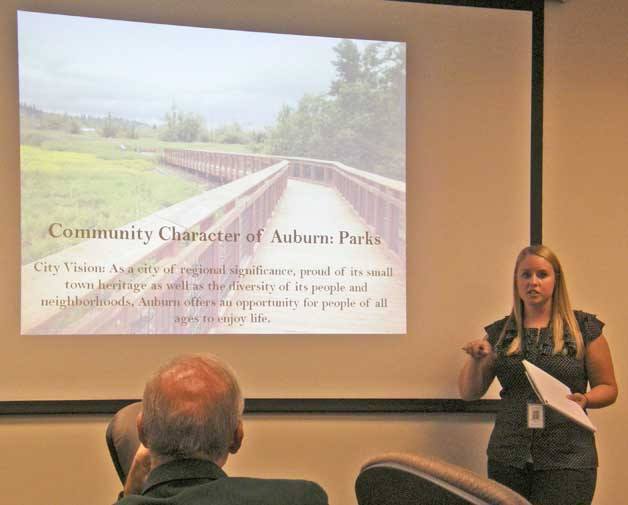Ashley Gonskey hopes what folks told her they want to see in the Auburn Environmental Park District in terms of zoning, development, businesses, even heights of buildings, makes its way into planning guidelines.
Hopes that City planners overseeing the AEP district’s development use what people told her.
“I want to help improve the quality of life here in Auburn,” Gonskey said, after presenting the results of her field survey recently to the Auburn Planning and Community Development Committee.
“We’re trying to bring in ideas about new business sustainability and bring in green aesthetics, which is the application of sustainability in a creative way, to Auburn,” Gonskey said.
Gonskey, 23, an Arizona State University graduate student in architecture, surveyed 50 residents, ages 30 and up, who came into the City’s Planning Department this past spring while she was an undergraduate student at Washington State University.
Gonskey divided her respondents into people who knew about the EPD and those who didn’t.
Here is some of what she learned:
• Fifty-six percent of the people surveyed want more manufacturing in the Auburn Environmental Park District, but 14 percent of those want only sustainable businesses there.
Gonskey said people told her they believed mixed-use zoning would be appropriate in the park district because it would provide direct application to the idea of a manufacturing village “and how we, under one roof, under one site, could place a variety of appealing functions.”
Gonskey conceded that the manufacturing question perhaps scared many people into saying no, because they “saw manufacturing and industry as something that’s ugly, and this project is about aesthetics and bringing beauty here.”
• Fourteen-percent said they wanted more small businesses to shop within the district, the same sorts of businesses found in the downtown.
• Ten percent supported residential areas in the district
Gonskey also asked whether the size of buildings depicted in student designs submitted last year and on display for those being surveyed to see were appropriate to the AEP District.
“A lot of it was split, 50-50, with people pointing at different posters to say what they liked the most. They saw the advantages of taller buildings with smaller buildings footprints, larger landscaping areas. People also worried that taller buildings would block views of nature and the area.”
A popular, “more Auburnesque alternative” Gonskey said, was was a complex of scattered buildings but of minimal height.
Gonskey said the toughest question was how buildings with green aesthetics would improve the quality of life in Auburn.
“It’s a loaded question and very hard to answer… I had a range of answers. A lot of people were very positive about green aesthetics improving the quality of life in Auburn. They thought of it as bringing in new jobs and making the city more attractive. In my opinion, I don’t think there was a wrong answer to this question. The problem people had with green aesthetics related to cost and they wanted to know and see where their dollars would be spent. I think that’s realistic.”
Councilman Rich Wagner said what suprised him most about Gonskey’s findings was that people didn’t give a clear answer as to whether they felt that residential development mingling with manufacturing in the AEP District would be a good idea.
“Do people want to live in a manufacturing district? Maybe they don’t,” Wagner said.
“I’m getting that same thing,” said Mayor Pete Lewis. “I was talking to some of the developers around here, and it kept coming back to me, ‘what you want doesn’t mean anything; it’s only what the market will bear.’ The reality is, unless it’s something really upscale, like a Microsoft-type thing, people don’t want to live there.”


